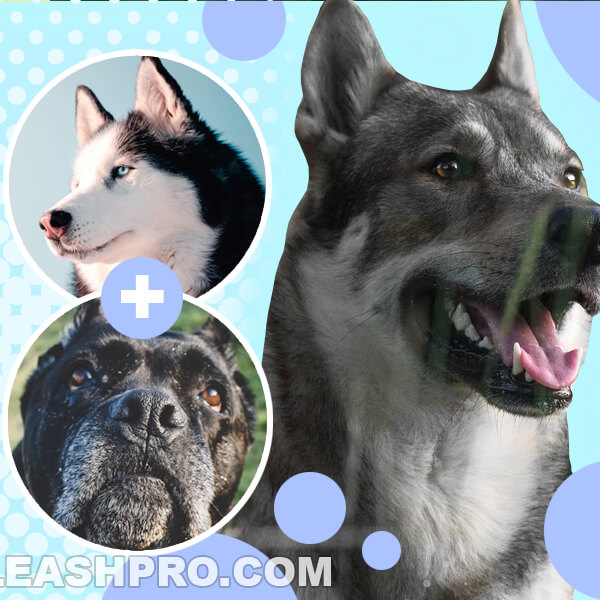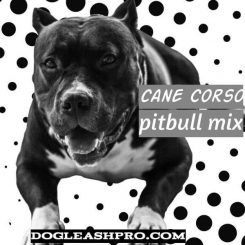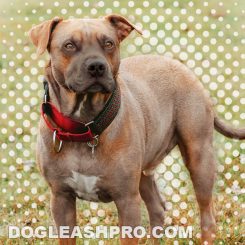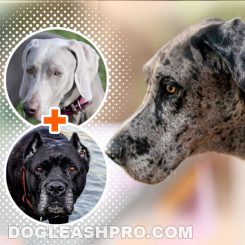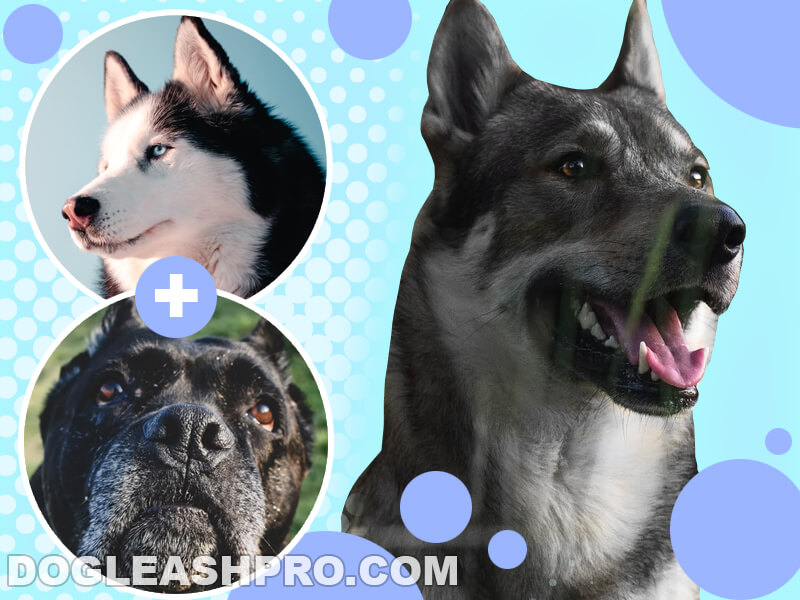
If you have a Cane Corso or a Husky, you know how loyal and protective they are of their owners and family. In recent years, Cane Corso has become very popular and many breeders have been crossing this breed with other purebred dogs.
While the Cane Corso Husky Mix is quite common, other mixes like Cane Corso Bullmastiff Mix or Cane Corso Bulldog Mix aren’t. In this article, we’ll discuss in-depth the Cane Corso Husky Mix, including their temperament, personality, physical appearance, size, health issues, and more! Let’s begin!
Table of Contents
What is a Cane Corso Husky Mix?
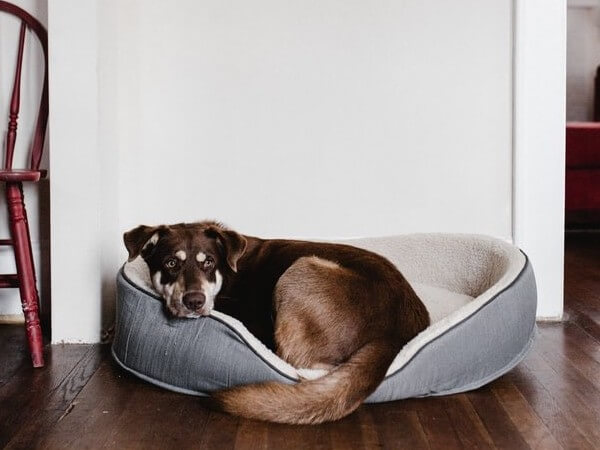
The Cane Corso is a popular dog for making crosses. While it has sired some remarkable mixes that people know and love, they’ve also bred to produce some unique crosses never seen before. One such mix is the Cane Corso Mixed with Husky.
You can’t find much info about the Cane Corso Mastiff and Husky Mix because there aren’t many Husky Cane Corso Mixes in the market.
Breeders prefer producing purebred dogs that can compete in dog shows. For them, a Cane Corso and Husky Mix will be nothing more than a mongrel.
However, some dog enthusiasts have experimented with the Cane Corso Mix with Husky and what they got was an exquisitely charming dog.
The seriousness of the Cane Corso combines well with the Husky’s mischievousness, and the Cane Corso Siberian Husky Mix combines the best qualities of both its parents.
So let’s explore the Cane Corso Husky in a bit more detail.
RELATED: Great Dane Husky Mix (Complete Guide)
Cane Corso vs Husky
Cane Corso Mix breeds usually combine the Cane Corso with a dog with a similarly imposing physique.
While the Husky is only slightly smaller, it weighs significantly less, meaning this Cane Corso Mix will be lighter and thinner than its Corso parent.
As with all Cane Corso Cross Breeds, the Cane Corso Husky Mix will have some traits from each parent and all traits that are common between Cane Corsos and Huskies.
Similarities between Cane Corso and Husky
| Cane Corso and Husky | |
| Purity | Purebred |
| AKC Recognition | Yes |
| Intelligence | Average |
| Hypoallergenic | No |
| Energy level | High |
| Owner experience | Medium |
| Health | Healthy |
Differences between Cane Corso and Husky
| Cane Corso | Husky | |
| Size | Large | Medium |
| Purpose | Working dog | Sledding dog |
| Origin | Italy | Russia |
| Coat | Smooth, short | Dense, medium |
| Shedding | Low | High |
| Grooming | Minimal | Moderate |
| Prey drive | Very high | Moderate |
| Affection | High | Very high |
| Barking | Moderate | High |
| Drooling | Moderate | Minimal |
| Weather preference | Warm to average cold | Cold to freezing |
| Lifespan | 9-12 years | 12-14 years |
RECOMMENDED: Greyhound Husky Mix (Complete Guide)
Cane Corso history
The ancestors of Cane Corso served in Roman armies as warrior dogs. After the Roman Empire fell, the Cane Corso’s ancestors were out of a job. So they were brought to the Italian countryside and bred with the local dogs. Thus, the Cane Corso came to be.
The Italians put the Corso’s stamina and obedience to good use by letting them work around farms. In addition, their hunting and tracking skills made them excellent hunters, and their ferocity made them exceptional guard dogs. The Cane Corso soon became the favorite dog among Italian farmers.
After the traditional farming system’s decline in Italy, Cane Corsos came to America. Here, they developed a pretty solid fan-following and began living as companion and guard dogs.
You might also like: Cane Corso Bulldog Mix – Complete Guide
Husky history
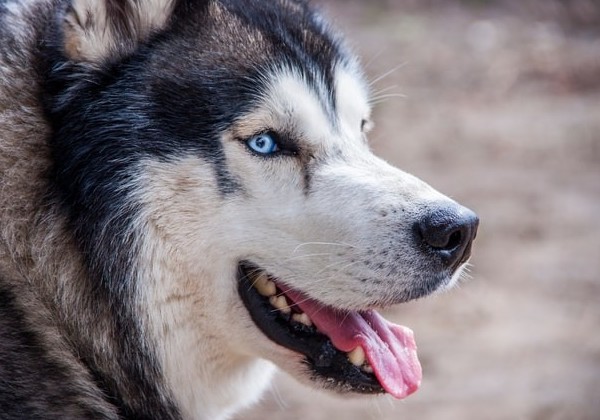
Siberian Huskies are one of the most ancient dog breeds. Early humans bred these dogs from wolves and used them to sled across the frozen landscapes during the ice age. Thousand of years later, the Husky is still the best sled dog around.
Although motorized vehicles have replaced them to some extent, the Husky is still popular among the Russians and Alaskans. Although seldom used for sledding these days, they’re still featured in sledding competitions.
Check out: St Bernard Husky Mix (Complete Guide)
Cane Corso and Husky as working dogs
Both the Cane Corso and the Husky are hardworking dogs in their fields. The Cane Corso is a reliable farmhand who can herd cattle, hunt large animals, remove vermin, and keep intruders at bay.
Similarly, the Husky has been a helpful companion for humans for thousands of years. Their endurance, strength, and ability to withstand harsh cold weather have made them ideal for use as sled pullers through the Russian and North American tundra.
Both dogs are active and full of energy and don’t like sitting idle. Whether you have a Cane Corso or Husky, make sure to give them plenty of work to do, along with activities that challenge them mentally.
Cane Corso Husky Mix physical appearance
To understand what a Cane Corso Husky would look like, let’s go through some of the physical traits of its parents.
Cane Corsos have athletic builds and fine, shiny coats that give them a regal and elegant look. They have strong legs, broad chests, large heads, and serious-looking faces.
Although their tails are long and their ears are big and floppy, it’s not uncommon to see them with docked tails and cropped ears as well.
Siberian Huskies look like small wolves, and their peculiar coat pattern helps protect them from getting mistaken as wolves. They have triangular, upright ears and bushy tails — which they sometimes wrap around their snouts for warmth.
Their eyes are hazel, black, or blue. Sometimes, they’re heterochromatic, meaning one eye is of a different color than the other.
A Cane Corso Husky Mix can take after either of its parents. Considering how different both breeds look, it would be interesting to see how their offspring appears.
You can expect your Cane Corso Husky Mix to carry random physical traits of its parents, with visible differences even in the same litter.
You may be interested in: French Bulldog Husky Mix (Complete Guide)
Cane Corso Husky Mix coat colors
Cane Corso comes in solid black, grey, fawn, and red colors. They may have a black or grey mask or carry tiger-like stripes in a brindle pattern.
Huskies are sometimes solid black or solid white, but they are famous for their dual-tone coats. Huskies come in agouti, black, brown, red, grey, and sable colors with white markings on legs and belly.
As with all mixed breed dogs, you can never say for sure what color a Cane Corso Husky Mix will have without looking at its parents. It can inherit any color combination from the Cane Corso and the Husky.
Cane Corso Husky Mix size, height, and weight
Although we consider Huskies medium-sized dogs, they’re borderline large.
Mixing a Cane Corso with a Husky results in a dog with a medium-large to large build. To understand how big a Cane Corso Husky can get, let’s take a look at the average heights of Cane Corso and Huskies.
Cane Corso
| Male | Female | |
| Size group | Large | Large |
| Height | 25 – 27.5 inches | 23.5 – 26 inches |
| Weight | 99 – 110 pounds | 88 – 99 pounds |
Husky
| Male | Female | |
| Size group | Medium | Medium |
| Height | 21 – 23.5 inches | 20 – 22 inches |
| Weight | 45 – 60 pounds | 35 – 50 pounds |
Judging by the above information, we can safely say that a Cane Corso Husky will be somewhere around 20 to 27 inches tall and weigh anywhere between 40 and 100 pounds.
You might also like: Cane Corso Great Dane Mix – Complete Guide
Cane Corso Husky Mix temperament and personality
The Cane Corso loves its owner and family and would defend them aggressively if a stranger approached them with malicious intent.
However, the dog should remain calm in front of non-threatening people. These dogs are brave, watchful, protective, and relentless.
Huskies are playful, energetic, and willing to please. These dogs can get jealous if they see someone else getting their owner’s attention, so it’s essential to train them when they’re young and teach them to get along with others.
Despite being very vocal, this dog doesn’t bark. They communicate in howls, which can be annoying to your neighbors. They get along with everyone and make poor guard dogs.
The Cane Corso and Husky Mix can carry a mixture of its parents’ traits, or it may lean towards its Corso or Husky side. In either case, you need to make sure he or she gets training early in his or her life.
Do Cane Corso Husky Mix get along with other pets?
The Cane Corso Husky Mix can get along well with other dogs if it receives socialization training at a young age. As for other pets, don’t expect it to tolerate their presence.
Cane Corso used to work around farms as expert pest hunters. Huskies lived in the harsh conditions of the Siberian and Alaskan tundra and would make a meal out of anything.
Combining the high prey drive these dogs inherit from both their parents, we recommend not letting your Cane Corso Husky Mix unsupervised with another pet animal.
Cane Corso Husky Mix training
Training your Cane Corso Husky Mix can be tricky. These dogs like making their owners happy and appreciate the stimulation training brings, but they can also be stubborn and commanding.
You need to train a Cane Corso Husky Mix with patience and love without showing subservience. Failing to exhibit an alpha dog attitude may lead to your Cane Corso Husky Mix becoming arrogant and refusing to listen.
Training should start in a distraction-free environment. Teach your Cane Corso Husky a command and reinforce it with encouragement and rewards. Make sure not to keep training sessions too long, or the dog will get bored and lose interest.
As the dog learns to obey the command, try changing settings and introducing distractions. With a gentle yet assertive approach, training your Cane Corso Husky Mix won’t be that difficult.
Cane Corso Husky Mix exercise requirement
Failing to meet your Cane Corso Husky’s exercise needs can spell disaster. These dogs would howl endlessly, dig holes all over your backyard, and shred whatever they could chew on if they were left alone with pent-up energy.
Your Cane Corso Husky will need two hours of exercise each day to keep them well-behaved. Add variety to their physical activity instead of keeping the same routine. Spread these activities across the day, depending on your convenience.
These dogs need wide open spaces to live. If you have a small apartment or a home without adequate moving space, this dog will be a nightmare to deal with.
You might also like: Cane Corso Doberman Mix – Complete Guide
Cane Corso Husky Mix grooming and cleaning
Cane Corsos are easy to groom, whereas Siberian Huskies require more regular upkeep. Their mix can be a low or high-maintenance dog, depending on which coat it inherits.
If your Cane Corso Husky Mix has a smooth and short coat, you’d only need to brush them once every two weeks. If it has a Husky-like double coat, the brushing frequency will be twice a week at least.
It’s not a good idea to bathe dogs too often, and the Cane Corso Husky Mix is no exception. Washing these dogs frequently will strip them of their natural oils and make their skin dry.
Bath your Cane Corso Husky only if it starts to stink. Use a mild soap or shampoo and rinse their fur thoroughly to get rid of any leftover soap.
The Cane Corso Husky doesn’t need haircuts, and their digging habits keep their nails short as well. However, pay special attention to their teeth and ear. Clean plaque buildup and earwax deposit regularly.
Is Cane Corso Husky Mix hypoallergenic?
No, Cane Corso Husky Mix is not hypoallergenic. Cane Corso Huskies are somewhat heavy shedders and wouldn’t suit people with dog allergies.
These dogs experience excessive shedding twice a year and shed moderately all year round, making them unsuitable to be around if you have a sensitivity to their fur and dander.
Cane Corso Husky Mix food and diet
Feed your Cane Corso Husky Mix a protein-rich meal made of beef, poultry, or fish. Although these dogs inherit their parents’ high energy, you should only feed them according to their lifestyle; a sled dog’s diet won’t suit them if they’re not pulling carts across frozen ground daily.
Unless your vet advises you otherwise, opt for natural options instead of synthetic nutritional supplements. Make sure to feed them a couple of smaller meals every day instead of one big meal to reduce the chance of bloat.
Cane Corso Husky Mix common health issues
Both the Husky and the Cane Corso are healthy canines that only suffer from genetic issues. You can avoid most of these congenital problems by checking the pup and parents’ health records before adopting. Some health issues you still need to be aware of are:
1. Cataracts
Huskies suffer from a multitude of eye issues, the most common of which is cataracts. This condition causes a clouded film to form in front of the dog’s lens, obstructing its vision and leading to gradual blindness. Curing this condition requires surgery.
2. Progressive Retinal Atrophy (PRA)
Progressive Retinal Atrophy, or PRA, is a degenerative disease that slowly makes the dog lose its vision. This condition has no cure, and the dog may completely lose its eyesight within years or months.
PRA affects the Husky through X chromosomal inheritance, meaning it affects females more than males.
You may be interested in: How To Soften Dog Eye Boogers?
3. Bloat
Bloat is a known problem in large dogs, such as the Cane Corso. Bloat is a gastric expansion of the stomach caused by overeating or eating too quickly. The buildup of gas doesn’t get expelled very quickly, and the dog may suffer in agony for hours.
Feeding small meals multiple times a day can reduce the chances of bloat.
4. Epilepsy
Epileptic seizures can be pretty scary for owners who have never seen them before. The exact reason for epilepsy is unknown, but it is an inherited condition.
Dogs may randomly have seizures even when nothing has stressed or frightened them. Luckily, mixed breed dogs have a much lower chance of inheriting this disease.
5. Follicular dysplasia
Follicular dysplasia occurs in Huskies more often than Cane Corsos. It causes the fur to become brittle and shed excessively, leading to bald patches.
In multi-colored dogs, it may affect the hair of only one color.
6. Hypothyroidism
The thyroid gland is responsible for producing the hormone thyroxine. This hormone controls the body’s metabolism and how the body turns food into energy. Hypothyroidism is when the thyroid gland can’t make enough thyroxine. This deficiency leads to obesity, lethargy, dull coat, and digestive issues.
7. Hip dysplasia
Although hip dysplasia is widespread among medium and large dogs, Huskies enjoy some of the lowest hip dysplasia rates. Unfortunately, the Cane Corso isn’t that lucky. Hip dysplasia occurs when the dog’s hip socket fails to develop correctly, leading to bone degeneration through constant friction.
8. Glaucoma
Glaucoma is when the internal fluid pressure inside the eyeball increases, causing swelling, pain, water discharge, and vision impairment. Glaucoma can be painful, and the affected dog also loses its appetite and vigor.
9. Cherry eye
Cherry eye affects Cane Corso frequently but isn’t a common issue among Huskies. Cherry eye happens when the dog’s tear gland swells and reddens, pretty much like a cherry. The condition isn’t dangerous or painful, but the dog may paw at it constantly and make it worse.
10. Corneal dystrophy
Corneal dystrophy is another eye issue that Huskies experience congenitally. In this condition, the dog’s eyes become clouded with ring-like shapes. Although this condition isn’t alarming and doesn’t affect the dog’s vision, it’s still best to get the dog checked by a vet to know if the disease will progress.
Cane Corso Husky Mix lifespan
The Cane Corso and Husky Mix have a decent lifespan between 10 to 14 years. As with all mix-breed dogs, this number can vary.
Many Huskies in America have come from a single ancestor, which is why some genetic disorders keep popping up among the Husky population.
Luckily, mixing them with Cane Corso introduces a much-needed genetic diversity, which purebred dogs lack. This diversity helps stave off many congenital diseases, giving the Cane Corso Husky Mix a longer lifespan.
Cane Corso Husky Mix adoption
Both the Cane Corso and Huskies get abandoned a lot. That’s because inexperienced owners can’t handle their requirements.
If you’re ok with adopting an older dog and live somewhere cold, do check out the local shelters. You might find many abandoned dogs waiting for a new home. If you’re lucky, you’ll meet a Cane Corso Husky Mix there too.
Cane Corso Husky Mix for sale
It won’t be easy finding a Cane Corso Husky for sale; this is especially true if you live somewhere warm. Huskies aren’t the first that dog breeders think of partnering a Cane Corso with, which is why the Cane Corso Husky can be pretty hard to find.
Nevertheless, scouring the internet and social media groups can help you find good breeders with healthy dogs for sale.
Is the Cane Corso Husky Mix right for me?
A Cane Corso Husky Mix will suit a moderately experienced dog owner with plenty of open space to let this dog move around. If you can put up with their high energy, give it the mental stimulation it needs, and put up with its howling, you’ll find the Cane Corso Husky an exceptional pet.
Related Questions
There are plenty of Cane Corso mix breeds you can choose from, mainly depending on what you want out of a canine companion. The Cane Corso Labrador, Cane Corso Doberman, and Cane Corso German Shepherd Mix are some really good mixes to have.
DISCLAIMER: THIS WEBSITE DOES NOT PROVIDE MEDICAL ADVICE
The information, including but not limited to, text, graphics, images and other material contained on this website are for informational purposes only. No material on this site is intended to be a substitute for professional veterinary advice, diagnosis, or treatment. Always seek the advice of your veterinarian or other qualified health care provider with any questions you may have regarding a medical condition.
Resources:
https://en.wikipedia.org/wiki/Husky
https://www.akc.org/dog-breeds/cane-corso/

With over five years of specialized experience as an animal writer, my expertise lies in dog nutrition, health, behavior, grooming, and training. I am dedicated to delivering helpful and informative content that caters to the well-being of our furry friends. My primary goal is to empower pet owners with knowledge and ensure our canine companions thrive in health and happiness. In my free time, I love volunteering at local dog rescue centers.
